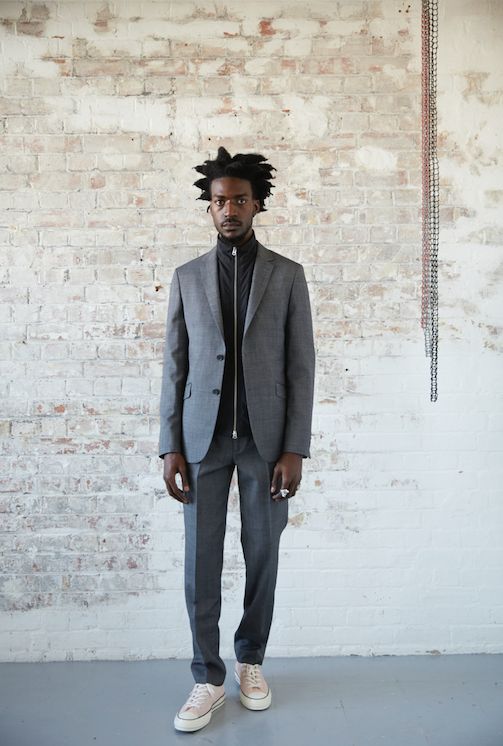
What is considered ‘workplace appropriate’ clothing varies from job and person. Even things confidently stated as universal ‘don’ts’ – flip-flops, bra-straps, shorts, clothing involving cut-outs – might be perfectly fine in some offices, while in others, open shirt necks or bare legs can prompt raised eyebrows.
So how to negotiate dressing for work without getting fired, going bankrupt or compromising your individuality? HuffPost UK asked some stylish dressers.
Gender

George Nicholson, Deputy Editor at The Idle Man, believes office wear can be “challenging” when you’re male. “You’re fairly limited in your options compared to your female peers,” says Nicholson. “But that doesn’t mean you have to be simple in your style.”
He argues that if you’re male in a formal office, dressing smartly is not negotiable. “A simple two-piece suit, clean shirt and black brogues will be your go-to outfit for the everyday,” he notes.
Things aren’t always so straightforward. Activist Phil Hill talks about her experience working in retail, where uniforms are commonplace. “It can be hard when you don’t conform to society’s gender norms yet people assume your gender and in this case, what clothes are best for you,” Hill says.
“When I go to work and request new uniform, people see I’m a woman and therefore think I want women’s clothes.” Having people assume what you ‘should’ be wearing can have a really negative effect, Hill says. “It usually makes me feel ten times worse about myself.”
“If a company is going to dictate what an employee wears, can we please just remember it’s 2018 – not everyone fits into a gender based box anymore.”
Dressing on a budget
The high street has lots of options for womenswear when money is tight. If your office is more formal than jeans and knitwear, you might consider buying a handful of dresses at a pricepoint you can afford – the joy of dresses is that they are complete outfits – along with one neutral jacket and a couple of pairs of shoes, and then rotate them. Even buying two frocks to begin with can work if you’re starting a new job and have little in the way of spare cash; build up a collection once your salary is helping your bank balance.
If you prefer trousers or skirts, committing to a restricted colour palette can help you get more mileage from tops and bottoms by mixing them up, so long as the shapes still work together.
For those looking to spend a little more more, consider buying better quality items rather than in higher volumes. Lovely fabrics make a real difference – a black dress that hangs really beautifully and is well-enough made to withstand repeated washing will be a staple for years. A really decent blazer will smarten any dress you put it over.
Nicholson thinks that the high street offers increasingly good choices when it comes to formal menswear on a budget – and if you can dispense with a suit jacket, it’s even less challenging. “While you might think that it might be expensive dressing smartly, you’d be mistaken,” he says. “A simple pair of trousers, a nice shirt and jumper can come in at under £100, which is surprisingly less than the days of old.”
How to still look like yourself
Rigid dress codes are less common though not completely unheard of in modern workplaces. But there are jobs where expressing your personality through clothes is important. According to London-based fashion editor Navaz Batliwalla, who blogs as Disneyrollergirl, today’s start-up culture is a blur of corporate boardroom and coffee shop.
“If you’re self employed and working in fashion, you want to be memorable,” Batliwalla tells HuffPost UK. “It’s worth having a signature ‘thing’, whether that’s your haircut or your glasses that you can be remembered for.”
Hairdresser Mark McIver, popularly known as Slidercuts, agrees that being workplace appropriate doesn’t mean foregoing your personal style. “Technically speaking, people can wear whatever they like as long as they do their work properly,” he says. “I feel like casual smart is great for creative industries, so you want the freedom to express yourself. It’s important to wear what creatively inspires you.”
But you don’t need to work in the creative industries to express yourself at work – adding colour into your wardrobe, even if the shapes are pretty safe, will allow you to turn a corporate uniform into something more interesting.
Smart casual – what is it exactly?
According to Debrett’s, knowing your context is crucial to navigating the tricky field of smart casual fashion. For professionals, this means reading the dynamics of the work place and taking cues from seniors. A good tip is to ask at interview or on day one of a new job. The Idle Man’s Nicholson believes that hats, jeans and trainers are still a no-go area for corporate men. “A crisp white shirt and quarter zip jumper are ideal pieces for bordering the smart yet casual look without overstepping the mark,” he advises.
“Being overdressed is much better than being underdressed,” he says. “You don’t want the reputation of being the guy in the office who comes in with scruffy trainers and baggy denim. It’s not a good look.”
Tahlia Gray, founder of tights company Sheer Chemistry, advises taking a day-by-day approach and tweaking your outfit so it fits the task at hand. “What you wear to pitch to a client versus what you wear for a day spent in front of your laptop or brainstorming with the team are going to be different,” she adds. “It’s definitely worth bearing this in mind. ”
Keeping the corporate culture of your organisation in mind is also really important, Gray says. Because Sheer Chemistry is a “fun, sophisticated” brand, that changes what she might wear to work. “Overall, we’re pretty relaxed but it’ll be no surprise to find a splash of colour or a bold print.”